
Funnelbeaker culture
Encyclopedia
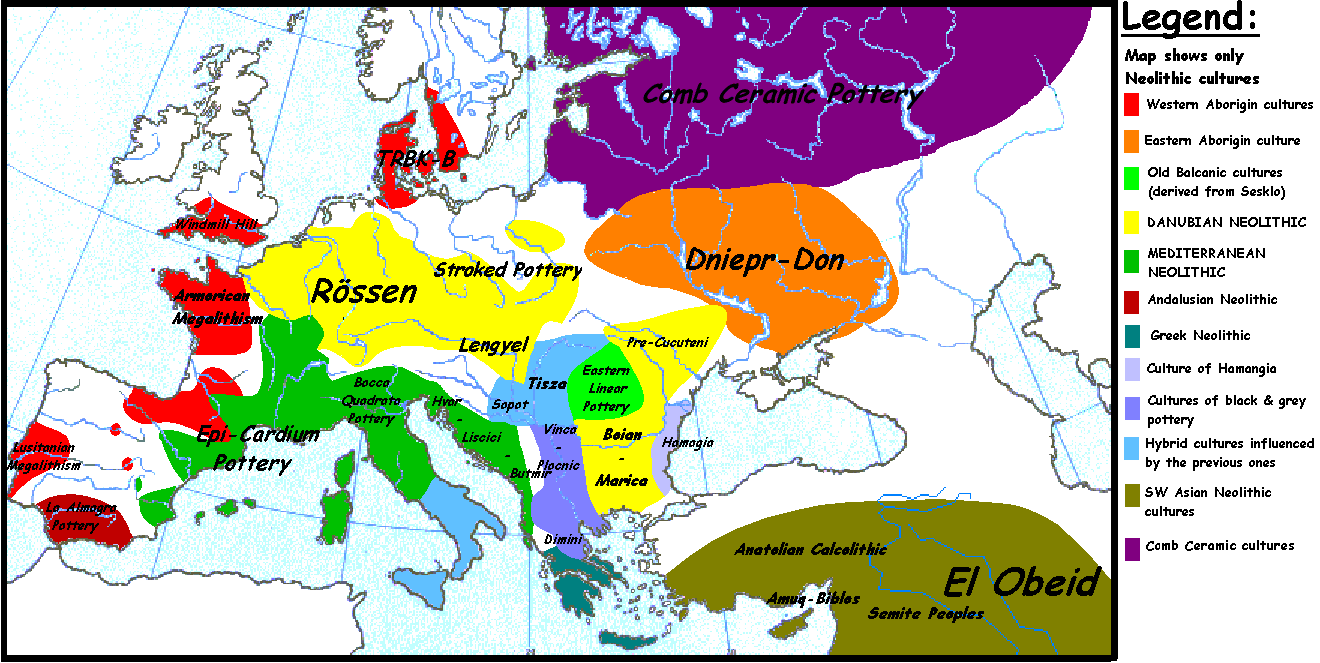

Megalith
A megalith is a large stone that has been used to construct a structure or monument, either alone or together with other stones. Megalithic describes structures made of such large stones, utilizing an interlocking system without the use of mortar or cement.The word 'megalith' comes from the Ancient...
ic culture
Archaeological culture
An archaeological culture is a recurring assemblage of artifacts from a specific time and place, which are thought to constitute the material culture remains of a particular past human society. The connection between the artifacts is based on archaeologists' understanding and interpretation and...
of late Neolithic Europe
Neolithic Europe
Neolithic Europe refers to a prehistoric period in which Neolithic technology was present in Europe. This corresponds roughly to a time between 7000 BC and c. 1700 BC...
.
Predecessor and successor cultures
The Funnelbeaker culture is preceded by the Ertebølle cultureErtebølle culture
The Ertebølle culture is the name of a hunter-gatherer and fisher, pottery-making culture dating to the end of the Mesolithic period. The culture was concentrated in Southern Scandinavia, but genetically linked to strongly related cultures in Northern Germany and the Northern Netherlands...
which is named after a Danish village. This predecessor culture was partly Neolithic
Neolithic
The Neolithic Age, Era, or Period, or New Stone Age, was a period in the development of human technology, beginning about 9500 BC in some parts of the Middle East, and later in other parts of the world. It is traditionally considered as the last part of the Stone Age...
but still primarily hunter-gatherer
Hunter-gatherer
A hunter-gatherer or forage society is one in which most or all food is obtained from wild plants and animals, in contrast to agricultural societies which rely mainly on domesticated species. Hunting and gathering was the ancestral subsistence mode of Homo, and all modern humans were...
. The successor culture was the Bell Beaker culture
Beaker culture
The Bell-Beaker culture , ca. 2400 – 1800 BC, is the term for a widely scattered cultural phenomenon of prehistoric western Europe starting in the late Neolithic or Chalcolithic running into the early Bronze Age...
, the Corded Ware culture
Corded Ware culture
The Corded Ware culture , alternatively characterized as the Battle Axe culture or Single Grave culture, is an enormous European archaeological horizon that begins in the late Neolithic , flourishes through the Copper Age and culminates in the early Bronze Age.Corded Ware culture is associated with...
and the overlapping Globular Amphora culture
Globular Amphora culture
The Globular Amphora Culture , German Kugelamphoren-Kultur , ca. 3400-2800 BC, is an archaeological culture preceding the central area occupied by the Corded Ware culture. Somewhat to the south and west, it was bordered by the Baden culture. To the northeast was the Narva culture. It occupied much...
.
Range
The TRB ranges from the ElbeElbe
The Elbe is one of the major rivers of Central Europe. It rises in the Krkonoše Mountains of the northwestern Czech Republic before traversing much of Bohemia , then Germany and flowing into the North Sea at Cuxhaven, 110 km northwest of Hamburg...
catchment in Germany
Germany
Germany , officially the Federal Republic of Germany , is a federal parliamentary republic in Europe. The country consists of 16 states while the capital and largest city is Berlin. Germany covers an area of 357,021 km2 and has a largely temperate seasonal climate...
and Bohemia
Bohemia
Bohemia is a historical region in central Europe, occupying the western two-thirds of the traditional Czech Lands. It is located in the contemporary Czech Republic with its capital in Prague...
with a western extension into the Netherlands
Netherlands
The Netherlands is a constituent country of the Kingdom of the Netherlands, located mainly in North-West Europe and with several islands in the Caribbean. Mainland Netherlands borders the North Sea to the north and west, Belgium to the south, and Germany to the east, and shares maritime borders...
, to southern Scandinavia
Scandinavia
Scandinavia is a cultural, historical and ethno-linguistic region in northern Europe that includes the three kingdoms of Denmark, Norway and Sweden, characterized by their common ethno-cultural heritage and language. Modern Norway and Sweden proper are situated on the Scandinavian Peninsula,...
(Denmark
Denmark
Denmark is a Scandinavian country in Northern Europe. The countries of Denmark and Greenland, as well as the Faroe Islands, constitute the Kingdom of Denmark . It is the southernmost of the Nordic countries, southwest of Sweden and south of Norway, and bordered to the south by Germany. Denmark...
up to Uppland
Uppland
Uppland is a historical province or landskap on the eastern coast of Sweden, just north of Stockholm, the capital. It borders Södermanland, Västmanland and Gästrikland. It is also bounded by lake Mälaren and the Baltic sea...
in Sweden
Sweden
Sweden , officially the Kingdom of Sweden , is a Nordic country on the Scandinavian Peninsula in Northern Europe. Sweden borders with Norway and Finland and is connected to Denmark by a bridge-tunnel across the Öresund....
and the Oslofjord
Oslofjord
The Oslofjord is a bay in the south-east of Norway, stretching from an imaginary line between the Torbjørnskjær and Færder lighthouses and down to Langesund in the south to Oslo in the north....
in Norway
Norway
Norway , officially the Kingdom of Norway, is a Nordic unitary constitutional monarchy whose territory comprises the western portion of the Scandinavian Peninsula, Jan Mayen, and the Arctic archipelago of Svalbard and Bouvet Island. Norway has a total area of and a population of about 4.9 million...
) to the Vistula
Vistula
The Vistula is the longest and the most important river in Poland, at 1,047 km in length. The watershed area of the Vistula is , of which lies within Poland ....
catchment in Poland
Poland
Poland , officially the Republic of Poland , is a country in Central Europe bordered by Germany to the west; the Czech Republic and Slovakia to the south; Ukraine, Belarus and Lithuania to the east; and the Baltic Sea and Kaliningrad Oblast, a Russian exclave, to the north...
.
Variants of the Funnelbeaker culture in or near the Elbe catchment area include the Tiefstich pottery group in northern Germany as well as the cultures of the Baalberge group
Baalberge group
The Baalburge group is a variant of the Funnelbeaker culture, ca. 3800—3500 BC, of the upper and central Elbe River catchment.It has been pointed to as an intrusive hybrid culture deriving ultimately from the steppe, and within the context of the Kurgan hypothesis as put forth by Marija...
(TRB-MES II and III; MES = Mittelelbe-Saale
Saale
The Saale, also known as the Saxon Saale and Thuringian Saale , is a river in Germany and a left-bank tributary of the Elbe. It is not to be confused with the smaller Franconian Saale, a right-bank tributary of the Main, or the Saale in Lower Saxony, a tributary of the Leine.-Course:The Saale...
), the Salzmünde and Walternienburg and Bernburg
Bernburg
Bernburg is a town in Saxony-Anhalt, Germany, capital of the district of Salzlandkreis. It is situated on the river Saale, approx. 30 km downstream from Halle. The town is dominated by its huge Renaissance castle featuring a museum as well as a popular, recently updated bear pit in its...
(all TRB-MES IV) whose centres were in Saxony-Anhalt
Saxony-Anhalt
Saxony-Anhalt is a landlocked state of Germany. Its capital is Magdeburg and it is surrounded by the German states of Lower Saxony, Brandenburg, Saxony, and Thuringia.Saxony-Anhalt covers an area of...
.
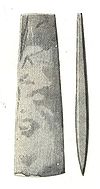
Settlements
With the exception of some inland settlements such as Alvastra pile-dwellingAlvastra pile-dwelling
The Alvastra pile-dwelling is a pile dwelling from ca 3000 BC in Ödeshög Municipality, Östergötland County, Sweden....
, the settlements are located near those of the previous Ertebølle culture on the coast. It was characterised by single-family daubed houses ca 12 m x 6 m. It was dominated by animal husbandry of sheep, cattle
Cattle
Cattle are the most common type of large domesticated ungulates. They are a prominent modern member of the subfamily Bovinae, are the most widespread species of the genus Bos, and are most commonly classified collectively as Bos primigenius...
, pig
Pig
A pig is any of the animals in the genus Sus, within the Suidae family of even-toed ungulates. Pigs include the domestic pig, its ancestor the wild boar, and several other wild relatives...
s and goat
Goat
The domestic goat is a subspecies of goat domesticated from the wild goat of southwest Asia and Eastern Europe. The goat is a member of the Bovidae family and is closely related to the sheep as both are in the goat-antelope subfamily Caprinae. There are over three hundred distinct breeds of...
s, but there was also hunting and fishing. Primitive wheat
Wheat
Wheat is a cereal grain, originally from the Levant region of the Near East, but now cultivated worldwide. In 2007 world production of wheat was 607 million tons, making it the third most-produced cereal after maize and rice...
and barley
Barley
Barley is a major cereal grain, a member of the grass family. It serves as a major animal fodder, as a base malt for beer and certain distilled beverages, and as a component of various health foods...
was grown on small patches that were fast depleted, due to which the population frequently moved small distances. There was also mining (e.g. in the Malmö
Malmö
Malmö , in the southernmost province of Scania, is the third most populous city in Sweden, after Stockholm and Gothenburg.Malmö is the seat of Malmö Municipality and the capital of Skåne County...
region) and collection of flintstone, which was traded into regions lacking the stone, such as the Scandinavian hinterland. The culture imported copper
Copper
Copper is a chemical element with the symbol Cu and atomic number 29. It is a ductile metal with very high thermal and electrical conductivity. Pure copper is soft and malleable; an exposed surface has a reddish-orange tarnish...
from Central Europe, especially dagger
Dagger
A dagger is a fighting knife with a sharp point designed or capable of being used as a thrusting or stabbing weapon. The design dates to human prehistory, and daggers have been used throughout human experience to the modern day in close combat confrontations...
s and axe
Axe
The axe, or ax, is an implement that has been used for millennia to shape, split and cut wood; to harvest timber; as a weapon; and as a ceremonial or heraldic symbol...
s.
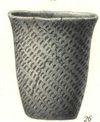
Religion and graves
The houses were centered around a monumental grave, a symbol of social cohesion. Burial practices were varied, depending on region and changed over time. Inhumation seems to have been the rule. The oldest graves consisted of wooden chambered cairnChambered cairn
A chambered cairn is a burial monument, usually constructed during the Neolithic, consisting of a cairn of stones inside which a sizeable chamber was constructed. Some chambered cairns are also passage-graves....
s inside long barrows, but were later made in the form of passage grave
Passage grave
thumb|250px|right|A simple passage tomb in [[Carrowmore]] near [[Sligo]] in IrelandA passage grave or passage tomb consists of a narrow passage made of large stones and one or multiple burial chambers covered in earth or stone. Megaliths are usually used in the construction of passage tombs, which...
s and dolmen
Dolmen
A dolmen—also known as a portal tomb, portal grave, dolmain , cromlech , anta , Hünengrab/Hünenbett , Adamra , Ispun , Hunebed , dös , goindol or quoit—is a type of single-chamber megalithic tomb, usually consisting of...
s. Originally, the structures were probably covered with a heap of dirt and the entrance was blocked by a stone. The Funnelbeaker culture marks the appearance of megalithic tombs at the coasts of the Baltic and of the North sea, an example of which are the Sieben Steinhäuser
Sieben Steinhäuser
The Sieben Steinhäuser is a group of five dolmens on the Lüneburg Heath in the NATO training area of Bergen-Hohne, in the state of Lower Saxony in northern Germany. The stones are considered to be part of the funnelbeaker culture...
in northern Germany
Germany
Germany , officially the Federal Republic of Germany , is a federal parliamentary republic in Europe. The country consists of 16 states while the capital and largest city is Berlin. Germany covers an area of 357,021 km2 and has a largely temperate seasonal climate...
. The megalithic structures of Ireland, France and Portugal are somewhat older and have been connected to earlier archeological cultures of those areas.

Axes and vessels were also deposed in streams and lakes near the farmlands, and virtually all Sweden's 10,000 flint axes that have been found from this culture were probably sacrificed in water.
They also constructed large cult centres surrounded by pales, earthworks and moats. The largest one is found at Sarup on Fyn
FYN
Proto-oncogene tyrosine-protein kinase Fyn is an enzyme that in humans is encoded by the FYN gene.This gene is a member of the protein-tyrosine kinase oncogene family. It encodes a membrane-associated tyrosine kinase that has been implicated in the control of cell growth...
. It comprises 85,000 m2 and is estimated to have taken 8000 workdays. Another cult centre at Stävie near Lund
Lund
-Main sights:During the 12th and 13th centuries, when the town was the seat of the archbishop, many churches and monasteries were built. At its peak, Lund had 27 churches, but most of them were demolished as result of the Reformation in 1536. Several medieval buildings remain, including Lund...
comprises 30,000 m2.
Objects
The culture is named for its characteristic ceramics, beakers and amphorae with funnel-shaped tops, which were probably used for drinking. One find assigned to the Funnelbeaker culture is the Bronocice potBronocice pot
The Bronocice pot is a ceramic vase incised with the earliest known image of what may be a wheeled vehicle. It was dated by the radiocarbon method to 3500-3350 BC and is attributed to the Funnelbeaker archaeological culture...
, which shows the oldest known depiction of a wheeled vehicle (here, a 2-axled, 4-wheeled wagon). The pot dates to approximately 3500 BC.
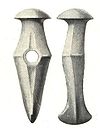
Flint
Flint is a hard, sedimentary cryptocrystalline form of the mineral quartz, categorized as a variety of chert. It occurs chiefly as nodules and masses in sedimentary rocks, such as chalks and limestones. Inside the nodule, flint is usually dark grey, black, green, white, or brown in colour, and...
-based, of which the deposits found in Belgium and on the island of Rügen
Rügen
Rügen is Germany's largest island. Located in the Baltic Sea, it is part of the Vorpommern-Rügen district of Mecklenburg-Vorpommern.- Geography :Rügen is located off the north-eastern coast of Germany in the Baltic Sea...
as well as deposits in the Kraków
Kraków
Kraków also Krakow, or Cracow , is the second largest and one of the oldest cities in Poland. Situated on the Vistula River in the Lesser Poland region, the city dates back to the 7th century. Kraków has traditionally been one of the leading centres of Polish academic, cultural, and artistic life...
area were important.
The culture used Battle Axe
Battle axe
A battle axe is an axe specifically designed for combat. Battle axes were specialized versions of utility axes...
s which were stone versions of Central Europe's copper
Copper
Copper is a chemical element with the symbol Cu and atomic number 29. It is a ductile metal with very high thermal and electrical conductivity. Pure copper is soft and malleable; an exposed surface has a reddish-orange tarnish...
axes. The early versions were multi-angled, and the later are called double-edged, although one of the edges is more rounded.
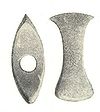
Ethnicity and language
In the context of the Kurgan hypothesisKurgan hypothesis
The Kurgan hypothesis is one of the proposals about early Indo-European origins, which postulates that the people of an archaeological "Kurgan culture" in the Pontic steppe were the most likely speakers of the Proto-Indo-European language...
, the culture is seen as non-Indo-European, representing the culture of what Marija Gimbutas
Marija Gimbutas
Marija Gimbutas , was a Lithuanian-American archeologist known for her research into the Neolithic and Bronze Age cultures of "Old Europe", a term she introduced. Her works published between 1946 and 1971 introduced new views by combining traditional spadework with linguistics and mythological...
termed Old Europe, the peoples of which were later to be governed by the Indo-European-language-speaking peoples (see Yamna culture
Yamna culture
The Yamna culture is a late copper age/early Bronze Age culture of the Southern Bug/Dniester/Ural region , dating to the 36th–23rd centuries BC...
) intruding from the east. The political relation between the aboriginal and intrusive cultures resulted in quick and smooth cultural morphosis into Corded Ware culture.
Heterodoxily, Dutch publications mention mixed burials and propose a quick and smooth internal change to Corded Ware within two generations occurring about 2900 BC in Dutch and Danish TRB territory, probably precluded by economic, cultural and religious changes in East Germany, and call the migrationist view of steppe intrusions introducing Indo-European languages obsolete (at least in this part of the world). It is more likely that Indo-European languages were adopted by local populations because they represented a new way of life, bringing with them horses and cattle and the status they represented.
Genetics
It has been suggested that the Funnelbeaker culture was the origin of the geneGene
A gene is a molecular unit of heredity of a living organism. It is a name given to some stretches of DNA and RNA that code for a type of protein or for an RNA chain that has a function in the organism. Living beings depend on genes, as they specify all proteins and functional RNA chains...
allowing adults of Northern European descent to digest lactose
Lactose
Lactose is a disaccharide sugar that is found most notably in milk and is formed from galactose and glucose. Lactose makes up around 2~8% of milk , although the amount varies among species and individuals. It is extracted from sweet or sour whey. The name comes from or , the Latin word for milk,...
. It was claimed that in the area formerly inhabited by this culture, prevalence of the gene is virtually universal. A paper published in 2007 by Burger et al. indicated that the genetic variant that causes lactase persistence in most Europeans (-13,910*T) was rare or absent in early farmers from central Europe. A study published by Yuval Itan and colleagues in 2010 clearly shows this. A study published in 2009, also by Itan et al., suggests that the Linear Pottery culture
Linear Pottery culture
The Linear Pottery culture is a major archaeological horizon of the European Neolithic, flourishing ca. 5500–4500 BC.It is abbreviated as LBK , is also known as the Linear Band Ware, Linear Ware, Linear Ceramics or Incised Ware culture, and falls within the Danubian I culture of V...
(also known as Linearbandkeramik or LBK), which preceded the TRB culture by some 1,500 years, was the culture in which this trait started to co-evolve with the culture of dairying. Ancient DNA extracted from three individuals ascribed to a TRB horizon in Gökhem, Sweden, were found to possess mtDNA haplogroups H, J, and T.
Sources
- J. P. Mallory, "TRB Culture", Encyclopedia of Indo-European CultureEncyclopedia of Indo-European CultureThe Encyclopedia of Indo-European Culture is an encyclopedia of Indo-European studies and the Proto-Indo-Europeans. The encyclopedia was edited by J. P. Mallory and Douglas Q. Adams and published in 1997 by Fitzroy Dearborn...
, Fitzroy Dearborn, 1997. - NationalencyklopedinNationalencyklopedinNationalencyklopedin is the most comprehensive contemporary Swedish language encyclopedia, initiated by a favourable loan from the Government of Sweden of 17 million Swedish kronor in 1980, which was repaid by December 1990...
- Wade, Nicholas, "The Twists and Turns of History, and DNA", The New York Times March 12, 2006.
- Pedersen, Hilthart, "Die jüngere Steinzeit auf Bornholm", München & Ravensburg 2008.

